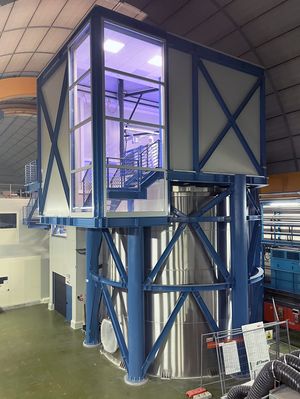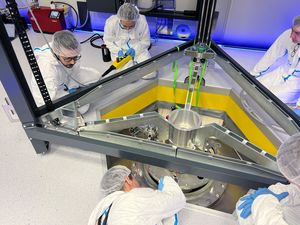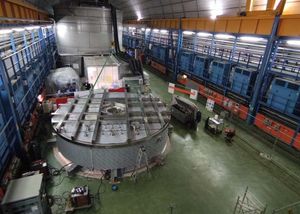COSINUS: Test of the DAMA experiment
Can the controversial dark matter signals of DAMA be confirmed?

In the search for the hypothetical dark matter particles, there are different approaches and methods. Many experiments involve searching directly for possible traces left behind by particles of dark matter when the atomic nuclei of normal visible matter are encountered. Examples are CRESST, Edelweiss, SuperCDMS, LUX, PandaX, DarkSide, and XENON-nT.
This also includes the DAMA/LIBRA experiment, which uses detectors made of sodium iodide. Thanks to its large detector mass (250 kg), it can detect another characteristic of dark matter particles. This entails a seasonal fluctuation in the observed signals – with a peak in June. The reason: The solar system revolves around the center of the Milky Way and the Earth around the sun. Depending on the position, the two relative speeds add up. As a result, our planet (and thus also the detectors) sometimes experiences a stronger or weaker particle wind.
However, the DAMA results are so far unconfirmed. In order to confirm the reliable detection of dark matter, other experiments must also be able to detect particle traces. Indeed, there are several projects (ANAIS in Spain, COSINE in Korea, and SABRE in Italy) in which scientists hope to reproduce the DAMA signals. However, none of them have been able to confirm the evidence for dark matter.
Combination of two detection methods
COSINUS will be added as a new testing instrument. The idea: COSINUS uses the same detector material as DAMA – sodium iodide. This is combined with a second detection channel – a special thermometer. When a dark-matter particle collides with the crystal, energy is deposited. This is manifested as a brief flash of light and a minuscule increase in temperature.
Over the next few years, COSINUS will be set up in the underground laboratory of the Gran Sasso (LNGS, Laboratori Nazionali del Gran Sasso) in Italy. The laboratory is located inside a massif, a natural bulwark against the interfering radiation from space. The experiment itself consists of 25 detectors surrounded by a seven-meter high water tank and thus protected from natural radioactivity. In the clean room above this setup, the detectors are prepared and installed in the experiment. The initial measurements are scheduled for 2022.
The project is led by a team from the Max Planck Institute for Physics, HEPHY, TU Wien, and INFN and GSSI (Italy). Other actors include SICCAS (China) and the Helsinki Institute for Physics (Finland).
COSINUS at the MPP
Group members
E-mail address: e-mail@mpp.mpg.de
Phone number: +49 89 32354-extension
name
function
e-mail
extension
office
Ackermann, Karlheinz
Engineering
karlheinz.ackermann
445
A.1.35
Angloher, Godehard, Dr.
Senior Scientist
godehard.angloher
445
A.1.35
Ansorge, Henrik
Student
henrik.ansorge
560
A.1.25
Bharadwaj, Mukund
PhD Student
mukund.bharadwaj
560
A.1.27
Boehnert, Lauren
Intern
lauren.boehnert
445
A.0.31
Braun, Sarah
Intern
sarah.braun
497
A.1.21
Dittmar, Clemens Johannes Udo
PhD Student
clemens.dittmar
497
A.1.21
Dörfler, Moritz
Student
moritz.dorfler
497
A.1.27
Figueroa Falla, Pablo Jose
Student
pablo.figueroa
379
A.1.33
Gaido, Elisa
Student
elisa.gaido
582
A.1.31
Gapp, Maximilian
PhD Student
maximilian.gapp
560
A.1.25
Heim, Kilian
Student
kilian.heim
560
A.1.25
Heinrich, Daniel
Student
daniel.heinrich
379
A.1.33
Hughes, Maximilian, Dr.
Postdoc
maximilian.hughes
582
A.1.31
Kellermann, Moritz
PhD Student
moritz.kellermann
497
A.1.27
Redl, Julia
Secretary
julia.redl
334
A.3.47
Schäffner, Karoline, Dr.
Senior Scientist
karoline.schaeffner
445
A.1.35
Shera, Kumrie
PhD Student
kumrie.shera
560
A.1.25
Stadler, Robert
Engineering
robert.stadler
330
B.2.35
Stahlberg, Martin, Dr.
Postdoc
martin.stahlberg
379
A.1.33
Sturm, Annette
Secretary
annette.sturm
482
A.3.45
Varela, Martina Belen
Student
martina.varela
582
A.1.31
Zema, Vanessa, Dr.
Postdoc
vanessa.zema
582
A.1.31
Ziegele, Lutz
Student
lutz.ziegele
497
A.1.21
Group members
Phone number: +49 89 32354-extension
| name | function | extension | office | |
|---|---|---|---|---|
| Ackermann, Karlheinz | Engineering | karlheinz.ackermann | 445 | A.1.35 |
| Angloher, Godehard, Dr. | Senior Scientist | godehard.angloher | 445 | A.1.35 |
| Ansorge, Henrik | Student | henrik.ansorge | 560 | A.1.25 |
| Bharadwaj, Mukund | PhD Student | mukund.bharadwaj | 560 | A.1.27 |
| Boehnert, Lauren | Intern | lauren.boehnert | 445 | A.0.31 |
| Braun, Sarah | Intern | sarah.braun | 497 | A.1.21 |
| Dittmar, Clemens Johannes Udo | PhD Student | clemens.dittmar | 497 | A.1.21 |
| Dörfler, Moritz | Student | moritz.dorfler | 497 | A.1.27 |
| Figueroa Falla, Pablo Jose | Student | pablo.figueroa | 379 | A.1.33 |
| Gaido, Elisa | Student | elisa.gaido | 582 | A.1.31 |
| Gapp, Maximilian | PhD Student | maximilian.gapp | 560 | A.1.25 |
| Heim, Kilian | Student | kilian.heim | 560 | A.1.25 |
| Heinrich, Daniel | Student | daniel.heinrich | 379 | A.1.33 |
| Hughes, Maximilian, Dr. | Postdoc | maximilian.hughes | 582 | A.1.31 |
| Kellermann, Moritz | PhD Student | moritz.kellermann | 497 | A.1.27 |
| Redl, Julia | Secretary | julia.redl | 334 | A.3.47 |
| Schäffner, Karoline, Dr. | Senior Scientist | karoline.schaeffner | 445 | A.1.35 |
| Shera, Kumrie | PhD Student | kumrie.shera | 560 | A.1.25 |
| Stadler, Robert | Engineering | robert.stadler | 330 | B.2.35 |
| Stahlberg, Martin, Dr. | Postdoc | martin.stahlberg | 379 | A.1.33 |
| Sturm, Annette | Secretary | annette.sturm | 482 | A.3.45 |
| Varela, Martina Belen | Student | martina.varela | 582 | A.1.31 |
| Zema, Vanessa, Dr. | Postdoc | vanessa.zema | 582 | A.1.31 |
| Ziegele, Lutz | Student | lutz.ziegele | 497 | A.1.21 |
Key publications
Deep-underground dark matter search with a COSINUS detector prototype
COSINUS Collaboration, G. Angloher
Collaboration
Phys.Rev.D 110 (2024)
10.1103/PhysRevD.110.043010
Particle discrimination in a NaI crystal using the COSINUS remote TES design
COSINUS Collaboration, G. Angloher
Collaboration
Phys.Rev.D 109 (2024)
10.1103/PhysRevD.109.082003
First measurements of remoTES cryogenic calorimeters: Easy-to-fabricate particle detectors for a wide choice of target materials
COSINUS Collaboration, G. Angloher
Collaboration
Nucl.Instrum.Meth.A 1045 (2023)
10.1016/j.nima.2022.167532
Simulation-based design study for the passive shielding of the COSINUS dark matter experiment
COSINUS Collaboration, G. Angloher
Collaboration
Eur.Phys.J.C 82 (2022)
10.1140/epjc/s10052-022-10184-5
Key publications
Deep-underground dark matter search with a COSINUS detector prototype
COSINUS Collaboration, G. Angloher
Collaboration
Phys.Rev.D 110 (2024)
10.1103/PhysRevD.110.043010
Particle discrimination in a NaI crystal using the COSINUS remote TES design
COSINUS Collaboration, G. Angloher
Collaboration
Phys.Rev.D 109 (2024)
10.1103/PhysRevD.109.082003
First measurements of remoTES cryogenic calorimeters: Easy-to-fabricate particle detectors for a wide choice of target materials
COSINUS Collaboration, G. Angloher
Collaboration
Nucl.Instrum.Meth.A 1045 (2023)
10.1016/j.nima.2022.167532
Simulation-based design study for the passive shielding of the COSINUS dark matter experiment
COSINUS Collaboration, G. Angloher
Collaboration
Eur.Phys.J.C 82 (2022)
10.1140/epjc/s10052-022-10184-5


![[Translate to English:] 3D design drawing of COSINUS in the Gran Sasso underground lab (LNGS) (Image: L. Giaffoni/U. di Sabatini/R. Stadler)](/fileadmin/_processed_/d/f/csm_COSINUS-setup_neu_01_1db23cbdd9.png)
